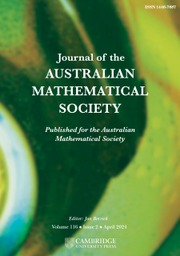No CrossRef data available.
Article contents
LOCAL COORDINATES FOR COMPLEX AND QUATERNIONIC HYPERBOLIC PAIRS
Published online by Cambridge University Press: 04 March 2021
Abstract
Let  $G(n)={\textrm {Sp}}(n,1)$ or
$G(n)={\textrm {Sp}}(n,1)$ or  ${\textrm {SU}}(n,1)$. We classify conjugation orbits of generic pairs of loxodromic elements in
${\textrm {SU}}(n,1)$. We classify conjugation orbits of generic pairs of loxodromic elements in  $G(n)$. Such pairs, called ‘nonsingular’, were introduced by Gongopadhyay and Parsad for
$G(n)$. Such pairs, called ‘nonsingular’, were introduced by Gongopadhyay and Parsad for  ${\textrm {SU}}(3,1)$. We extend this notion and classify
${\textrm {SU}}(3,1)$. We extend this notion and classify  $G(n)$-conjugation orbits of such elements in arbitrary dimension. For
$G(n)$-conjugation orbits of such elements in arbitrary dimension. For  $n=3$, they give a subspace that can be parametrized using a set of coordinates whose local dimension equals the dimension of the underlying group. We further construct twist-bend parameters to glue such representations and obtain local parametrization for generic representations of the fundamental group of a closed (genus
$n=3$, they give a subspace that can be parametrized using a set of coordinates whose local dimension equals the dimension of the underlying group. We further construct twist-bend parameters to glue such representations and obtain local parametrization for generic representations of the fundamental group of a closed (genus  $g \geq 2$) oriented surface into
$g \geq 2$) oriented surface into  $G(3)$.
$G(3)$.
Keywords
Information
- Type
- Research Article
- Information
- Copyright
- © 2021 Australian Mathematical Publishing Association Inc.
Footnotes
Communicated by Ben Martin
K. Gongopadhyay acknowledges partial support from SERB-DST MATRICS project MTR/2017/000355. S. B. Kalane is supported by an IISER Pune Institute post doctoral fellowship.


